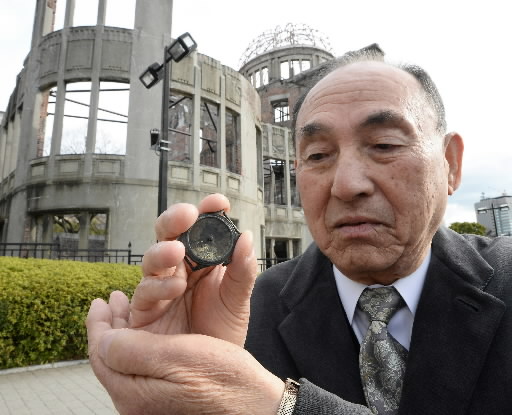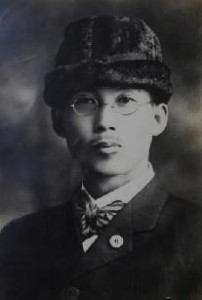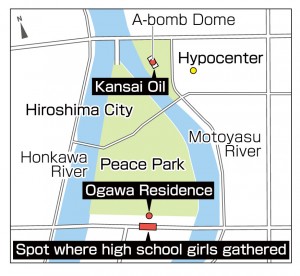Hiroshima: 70 Years After the A-bombing: Relics of the A-bombing 1
Jul. 3, 2014
Father’s watch
Next year will mark the 70th anniversary of the atomic bombing. Is the devastation it caused known by people of all ages around the world? In this series of articles, “Hiroshima: 70 Years After the A-bombing,” the Chugoku Shimbun will take another look at the accounts of survivors and various materials in an effort to record the reality of the atomic bombing and the feelings it evoked and to consider what sort of peace is needed to build the future. The series will begin with articles featuring personal belongings found amid the devastation in the hypocenter area, where entire neighborhoods were wiped out, and traces the lives of family members who donated the victims’ belongings to the Peace Memorial Museum.
Death at the A-bomb Dome: “I want young people to imagine what it must have been like.”
Hiroshima resident Fumiya Ikeda, 80, picked up the memento of his father and said, “I wish this watch could talk…” Mr. Ikeda and his mother found the watch inside the A-bomb Dome. The only thing still legible on the burned face of the watch is the engraved words “Swiss Made.”
According to Volume 2 of “Record of the A-Bomb Disaster” issued by the City of Hiroshima in 1971, “All 30 of the people inside the hall were killed instantly.” The building was located almost directly below the spot where the atomic bomb went off, and the remains of most of the victims could not be identified. The wristwatch, which Mr. Ikeda’s family donated to the Peace Memorial Museum, is the only item in the museum’s collection that was worn by a victim killed in the A-bomb Dome.
Early on the morning of August 6, 1945, Mr. Ikeda’s 52-year-old father Shigeyoshi, left their home in Senda-machi (now part of Naka Ward) and went to work at Kansai Oil Co. The company’s offices were located in the Prefectural Industrial Promotion Hall, later known as the A-bomb Dome.
Fumiya, then a sixth-grader at Senda National School (now Senda Elementary School), was at home with his mother, Kokiku, 47, brother Hiroshi, 23, and three other family members at the time of the A-bombing. Glass flew into Hiroshi’s right eye, and he spent the night at the Hiroshima Red Cross Hospital.
The next day Fumiya, his mother and uncle walked along the streetcar tracks into the city to look for his father. “The soles of my shoes got hot, and the inside of the dome was filled with collapsed bricks and other rubble,” Fumiya said. “Countless bodies were floating in the Motoyasu River.”
They went into the city again on August 9. Pawing through the rubble they found Shigeyoshi’s skeletal remains, still seemingly sitting at his desk. Kokiku recognized what little was left of the pants her husband had been wearing. They gathered up the bones and Shigeyoshi’s watch, which was nearby, wrapped them in a facecloth and took them home.
Kokiku also went in search of Fumiya’s brother Kazuo, who was five years older, who had gone to work as a mobilized student, but no trace of Kazuo was ever found.
After the family lost its breadwinner to the A-bomb, Kokiku sold off her kimonos, and Hiroshi, who lost the vision in his right eye, went to work and supported the family. Fumiya graduated from college and went to work for an automobile dealership. Hiroshi died in 1977. Fumiya said his family never talked about the A-bombing.
Kokiku kept the watch on the family’s Buddhist altar, but in 1985, after talking it over with Fumiya, she donated it to the Peace Memorial Museum. “She never said so, but I think she wanted to let future generations know what really happened.” Kokiku died in 2000 at the age of 101.
Fumiya has no desire to tell others of his experiences, and he has not talked about them with his grandson, who is about to enter high school. “Rather than expressing it in words, I’d like him to look at this watch. I’d like young people to try to imagine what would happen if another atomic bomb were used,” Fumiya said, describing the hope the memento of his father carries with it.
(Originally published on February 3, 2014)










